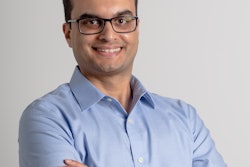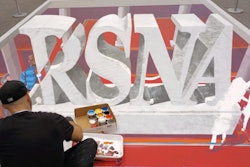
Despite the reduced footfall on the exhibit floor at RSNA 2021 and the absence of some major vendors, there was an excited focus, as attendees once again met in person to have both serious structured conversations and quieter off-the-record catchups.
These discussions focused on the products that will help shape radiology's future for years to come. Cloud capability, artificial intelligence (AI) enhancement, and breakthrough imaging technologies were prominent, as well as new products that will help providers efficiently and economically deliver care to patients.
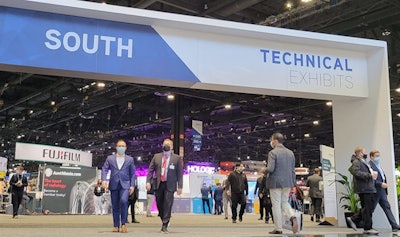 And they're off! Around 19,000 people attended RSNA 2021.
And they're off! Around 19,000 people attended RSNA 2021.Moreover, RSNA this year felt like a transitory year, in which the harsh lessons of recent disruption were manifested in a more assured and brighter future for the industry. Below are the overriding impressions of market analysts from Signify Research who attended the event.
Steve Holloway, executive director, Healthcare IT
It is often hard to distill down the diverse whirlwind of information garnered from a major international show, such as the RSNA, into concise trends. However, three key themes underpinned most of the main announcements and innovations:
- Imaging has got serious about efficiency. COVID-19 and overstretched radiology resources have driven innovation toward a greater focus on automation, integration, and cost-efficiency. Whether in the technology of scheduling, image acquisition, radiologist workflow, reporting, and dissemination of diagnosis to the wider health system, radiology's service line performance is going to be measured and focused on more than ever before.
- Unprecedented public and private funding is buoying the imaging market and driving renewed R&D spending in the sector. Competitiveness is perhaps at an all-time high, even with the yawning gap left in the tradeshow floor from recent high-profile disruptors (such as United Imaging) and established global vendors (Canon Medical). With imaging market subsectors still fragmented -- ultrasound, radiography, imaging IT, AI -- it feels as though the market is readying itself for a period of consolidation. Major vendors are sizing up potential acquisition targets, trying to find the right balance of ensuring market traction from potential assets, yet not waiting too long and losing out to the competition or having to overpay.
- Digitalization in imaging is finally starting to reach maturity, with a growing understanding of the diagnostic power that digital imaging brings. While still nascent in deployment, growing confidence in the value of AI, cloud technology, and analytics is starting to reshape the role of radiology in broader diagnosis. Integration of richer, more diverse data into the radiology workflow is already underway, as is the broader dissemination and potential benefit of imaging data into new parts of the health system. This was especially notable at the show in pathology, oncology, pharmaceuticals, and life sciences.
Above all, there is a growing realization that a medical image is no longer a snapshot of a patient's condition at a specific time; instead, new digital technology has the potential to use the image as a means of predicting outcomes in the future.
Dr. Sanjay Parekh, Senior Analyst
There are always a myriad of talking points around AI, especially at RSNA. This year, the following themes recurred:
- Consolidation has not yet happened. Although expected, there is limited evidence of a thinning of the field via mergers and acquisitions (e.g., Nanox acquiring Zebra Med). Furthermore, there were several new vendors exhibiting at RSNA this year, further adding to a crowded sector. The strength of some vendors is becoming more evident, on the back of strong funding rounds in 2021. For example, Viz.ai ($152 million venture capital funding [135 million euros], March 2021) Aidoc ($140 million [125 million euros], July 2021), and Infervision ($215 million [191 million euros], August 2021) all now have substantial firepower. Most recently, at RSNA, Lunit ($134 million [119 million euros]) and Annalise.ai ($129 million [115 million euros]) also joined the "over $100 million in funding" club. While funding alone is not a marker for long-term success and category leadership, new financial firepower will allow these firms to build new products, attract new talent and build channel more quickly. This should create a clearer differentiation in the near term between vendors that are commercially scaling, versus those that remain stuck in "pilot" mode.
- Partnerships between AI vendors were more prevalent, suggesting that collaboration is becoming increasingly important in this highly competitive market. Vendors are acknowledging that they cannot do everything alone, with partnerships a quicker way to expand their product portfolio, rendering them more attractive to healthcare providers than those with solitary products. Less established were partnerships between AI vendors and imaging IT vendors, most of whom are still only working with a very small and select group of AI vendors so far.
- Vendors targeting acute conditions were increasingly focused on delivering value beyond image analysis, such as mobilizing the response team to reduce turnaround time for treating stroke patients. "End-to-end" solutions for critical conditions were more prevalent, with a growing expansion for conditions beyond stroke, such as pulmonary embolism care.
- AI platforms to "curate AI," addressing the last-mile challenges of deploying, integrating, and orchestrating AI, were again on show, with some new releases also. However, there remains a disconnect between the AI vendors, platform vendors, and end-users. While some new partnerships and integrations were announced, most are a long way off widespread integration and commercial use in day-to-day imaging services. Furthermore, the business model and key question of "who pays" for AI has yet to be answered coherently by any vendor.
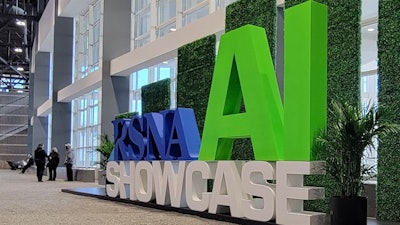 AI was a dominant theme at this year's meeting.
AI was a dominant theme at this year's meeting.As this market matures, the distinction between "end-to-end" solutions (care coordination) and AI platforms will gradually blur, and those vendors that offer the greatest value to providers by providing a broader care solution (integrated platform, workflow, and AI tools) will achieve greatest market traction and success. While RSNA 2021 showed that this has become more accepted on the tradeshow floor, executing and achieving comprehensive end-to-end offerings still seems some way off.
Bhvita Jani, Senior Market Analyst
Within the medical imaging market, leading global vendors had heightened focus on their MRI and CT portfolios, with not only increased presence of onsite prototypes but more notable product launches being showcased. It was clear that CT and MRI were at the forefront of innovation with the newest features primarily focused on workflow optimization, automated protocols, and image reconstruction.
Imaging vendors also demonstrated how AI-powered workflows can be used to increase workflow efficiencies and maximize patient throughput, resulting in a higher return on investment. Expansion of high-end features and software tools to the more affordable performance imaging systems in order to make them more scalable was also a prominent theme.
The recent pace of innovation within the CT market was demonstrated at RSNA 2021, spearheaded by cloud computing, AI, and expansion of modern engineering. The latest leaps in technology were highlighted including both the world's first photon-counting CT system and the world's first spectral detector-based CT, both of which empower greater clinical confidence due to higher spatial resolution, as well as a reduction in dose, to provide first-time-right diagnosis.
Improvements in the scalability of CT installations by the increased number of upgradable options for CT detectors without replacement of the gantry needed were also exhibited, to enable radiology departments to remain up to speed on the latest technology developments and help streamline fleet management to reduce operating costs. Some of the premium features displayed were motion correction and intelligent protocoling using patient demographics such as age, height, and weight.
For MRI, the underlying themes on show at RSNA 2021 include reduced helium or helium-free MRI systems, as well as AI-powered enhancements to improve image quality, workflow efficiency, and productivity. Key applications of this include automating clinical protocols or protocol suggestions using deep learning.
Improving the speed at which MRI scans are performed continued to be a core focus to increase patient throughput. Leading MRI vendors not only launched high-end solutions but also focused on their lower-end performance portfolio to improve access to MRI imaging. From a hardware perspective, improvements include making the MRI systems easier to install by making them lighter via to new magnet designs. As always, newer MRI systems also included larger bore sizes, with the latest features allowing the bore size to be upgraded without the need for reinstallation. Application of deep-learning AI was focused on image reconstruction to reduce noise and artifacts to produce signal-rich images.
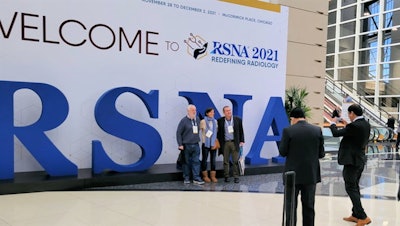 For many delegates, the congress was the first face-to-face meeting they'd attended for over two years.
For many delegates, the congress was the first face-to-face meeting they'd attended for over two years.A key theme for x-ray systems was ergonomic designs to reduce technician strain and improve user experience. Hardware features, such as a collapsible column or easier positioning on mobile digital radiography systems, aimed to reduce workplace injury, which affects 83% of radiographers. Additional advances for the radiographer include larger monitors, reducing the number of clicks per exam, and increased sensitivity of touchpoints.
As seen with previous years, a continued focus on making the systems more compact, lighter, and easier to install was also prominent to address the universal trend of increasing access to medical imaging outside of traditional settings. Workflows within x-ray are increasingly adopting intelligent and automated positioning features, including AI-powered camera-based workflows and autotracking features. The latest innovation included using depth cameras to obtain digital patient measurements. Flat-panel detector companies exhibited glass-free technology, flexible technology, newly launched long-length detectors, and the world's first curved detector.
Mustafa Hassan, Market Analyst
With the reduced footfall at this year's RSNA, the conversations between ultrasound original equipment manufacturers (OEMs) and their customers were less in quantity but higher in quality. As expected, there were not many new ultrasound product releases. Instead, vendors released products earlier in the year as and when they were ready, rather than holding back the release specifically for RSNA 2021, as was often the case in previous years. This trend is likely to stick in the coming years, with vendors expected to place less emphasis on using the major conferences as a platform to launch new products. While there were no new flagship premium systems from the major vendors this year, some of the midtier vendors released new higher-end systems, while the market leaders focused on offering a greater portfolio selection for customers to take advantage of, depending on their budget.
Instead of new systems at RSNA 2021, there was instead an expansion on already available products, through the introduction of new features and software applications, such as tools for liver imaging. There were also new AI features introduced and in line with our predictions before RSNA for a focus on efficiency, the new AI features introduced were primarily for image capture and workflow automation, enabling faster scans. Surprisingly, however, there were not many teleultrasound platforms showcased at RSNA 2021 to help hospitals with workflow challenges.
The ultrasound AI market is developing with a notable increase in new AI features from the ultrasound OEMs, alongside a handful of independent AI specialists dotted around the exhibition floor. There were AI solutions for a range of tasks: from image capture assistance to image analysis (quantification) and decision support. The focus for the independent ultrasound AI vendors continues to be breast, cardiology, and thyroid applications, while there was a greater variety of tools from the ultrasound OEMs, including tools for analysis of the uterus and liver fat quantification.
While still in the early stages, it is now clear that AI will play an increasingly important role in ultrasound in the coming years.




